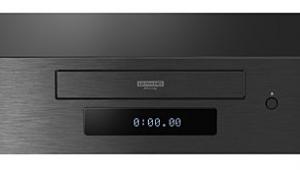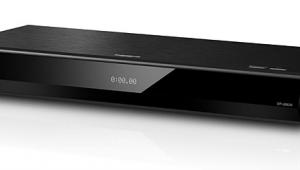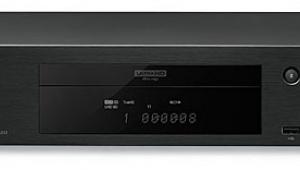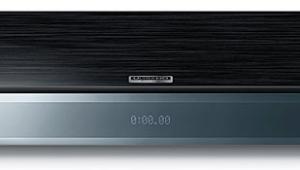PlayStation3 Blu-ray Disc Player Page 3
Also the PS3 allows users to stop a Blu-ray disc and resume play at the point you left off, while Toshiba's first generation HD DVD players left this convenient feature behind.
The bottom line is that the Cell processor must be the real deal, because the PS3 unequivocally flies, even with 1080p video and six channels of uncompressed PCM on tap. So far it is the only BD player I've seen that achieves the level of speed and stability we've enjoyed with DVD players for years, and takes it to the next-gen level.
Performance
During the time I've spent with the PS3 I've also had the VPL-VW50 "Pearl" projector to use it with, which is Sony's latest $5K, 1080p SXRD rig. My screen is an 80" wide Stewart StudioTek 130. I also compared the PS3 directly to the updated version of Samsung's BD-P1000 BD player, which has fixed the faulty NR circuit that made it excessively soft and noisy on release, and I was able to briefly compare it to Sony's standalone BDP-S1 Blu-ray player. I also have Toshiba's HD-XA1 HD DVD player, which I occasionally used for comparing titles duplicated on Blu-ray and HD DVD.
While Blu-ray software continues to be mysteriously variable in video quality, the PS3 was entirely consistent in providing excellent performance that was just a bit sharper and more detailed than Samsung's BD-P1000. Like Editor Tom Norton, I've now seen what Blu-ray can do, and it can be unequivocally glorious, regardless of which of the three video codecs are used (MPEG-2, MPEG-4/AVC, and VC-1 have all been used on BD) or whether the disc is 25GB or 50GB.
Jumping in, Mission: Impossible 3 (Paramount, MPEG-2, 25GB) is one of the best BD releases I've seen and among the best film-sourced HD I've seen on either format, placing it firmly among the best HD I've seen period. This relentlessly silly action movie has terrific depth and detail, with outstanding dimensionality (in video terms, not plot or characterization). Check the Vatican sequence starting in chapter 7. While every area of the screen during this sequence is rich in minute architectural detail, look at the rock solid detail in the Vatican in the background as Cruise lies on the ledge, including the moss and texture in the bricks on the ledge itself, the weave of his coveralls, and the backdrop of Rome behind. This transfer is not only excellent overall, I found it be a little gritty and grainy in good, film-like ways.
This is gorgeous stuff, and it clearly shows that BD can provide picture quality that's better than broadcast HD. This MPEG-2 transfer also holds up exceedingly well compared with the equally fine VC-1 encode that's on the equally outstanding HD DVD version of M:I 3. Switching between the 1080p Blu-ray output of the PS3 and the 1080i feed from the Toshiba HD DVD player I saw nothing to choose from between these excellent transfers.
Fox's release of X-Men: The Last Stand is AVC encoded on a 25GB BD. On this disc I could see better fine detail in facial hair and skin texture (Wolverine sports a lot of both at all times!) on the PS3 than the updated Samgung BD-P1000, and the colors seemed to jump out just a little more. This transfer is going to bother some people because there is a very noticeable grain structure, and while it's not tack sharp at all times it generally looked terrific to me. Although I didn't see this movie theatrically, for me the grain structure enhanced the experience by looking film-like, and not digitally sterile, and it seemed to me that the slight softness at times was a product of the original photography. Through much of the film I saw excellent resolution and color depth. In short, if all my HD looked like this you'd get few complaints from me at all.
Sony's MPEG-2 encoded releases of Tears of the Sun and Black Hawk Down succeed in strikingly contrasting methods. Both are stunning in their film-like portrayal of grain, and as razor sharp in detail as any HD I've ever seen. While BHD is nearly 2 1/2 hours in length on a dual-layer 50GB BD, and the shorter Tears is confined to a single-layer 25GB BD, the former is an amazing transfer by sheer brute force of bitrate, consistently running at video bitrates of 25-29Mbps. Yet Tears is every bit its equal and rarely peaks above 18-19Mbps.
The idea that the combination of 25GB discs and MPEG-2 coding are a death knell for video quality is clearly challenged by what I've seen here. And frankly, it points the finger at the either the quality of the HD masters, or the skills of the compressionists or other techies working on the BDs that don't meet the high standards of those mentioned above. It could also mean that the studios, Sony included, need to choose movies with higher quality masters, or do new and better mastering jobs for many titles in the vaults. But the bad looking discs aren't just the older titles like Fifth Element; Talladega Nights is flat and compressed looking even though it's on a 50GB dual-layer BD.
Regardless of these details, the reference quality Blu-ray titles on the PS3 show that the format is capable of the kind of transcendent HD performance we've all hoped to see from the next-gen formats. The fact that I can draw these distinctions about the overall video quality without the format getting in the way is in itself a triumph. This is in stark contrast to my first experiences with BD on the early version of the Samsung BD-P1000, which made just about everything look problematic.
Now, let me be even more clear: Blu-ray unequivocally has the potential to offer picture quality that is the equal of the outstanding image quality that we've seen from HD DVD. In fact, it's a pity that a BD player this good couldn't have launched Blu-ray because the format's performance potential would not have been in question as it was earlier this year when only the defective Samsung BD-P1000 was available.
Nevertheless, regardless of the codec or title, the PS3 looked very subtly sharper than the updated Samsung in direct comparison, yet still natural. It wasn't an artificially enhanced form of sharpness. But I must admit that these differences were something I had to look for hard enough to regard the differences as elusive observations more than outright criticisms. Keep in mind though that before its firmware fix the Samsung wouldn't have been in the conversation.
But here's another tidbit. As Tom Norton found during his review of the Panasonic DMP-BD10 Blu-ray player, I also saw that VC-1 encoded discs of the same titles looked slightly sharper on HD DVD from the Toshiba HD-XA1 outputting 1080i. Titles I looked at included Blazing Saddles, Corpse Bride, and Phantom of the Opera. It was slight, but this perception held up with all these discs in spite of the fact that a very well –placed source at Microsoft has told me that Warner used virtually identical VC-1 encodes for Blu-ray and HD DVD versions of these films.





























































